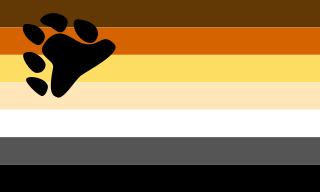Related Research Articles
Heterosexuality is romantic attraction, sexual attraction or sexual behavior between persons of the opposite sex or gender. As a sexual orientation, heterosexuality is "an enduring pattern of emotional, romantic, and/or sexual attractions" to persons of the opposite sex; it "also refers to a person's sense of identity based on those attractions, related behaviors, and membership in a community of others who share those attractions." Someone who is heterosexual is commonly referred to as straight.
Sexual orientation is an enduring pattern of romantic or sexual attraction to persons of the opposite sex or gender, the same sex or gender, or to both sexes or more than one gender. These attractions are generally subsumed under heterosexuality, homosexuality, and bisexuality, while asexuality is sometimes identified as the fourth category.
Queer is an umbrella term for sexual and gender minorities who are not heterosexual or are not cisgender. Originally meaning "strange" or "peculiar", queer came to be used pejoratively against those with same-sex desires or relationships in the late 19th century. Beginning in the late 1980s, queer activists, such as the members of Queer Nation, began to reclaim the word as a deliberately provocative and politically radical alternative to the more assimilationist branches of the LGBT community.

LGBT or GLBT is an initialism that stands for lesbian, gay, bisexual, and transgender. In use since the 1990s, the term is an adaptation of the initialism LGB, which began to replace the term gay in reference to the broader LGBT community beginning in the mid-to-late 1980s. The initialism, as well as some of its common variants, functions as an umbrella term for sexuality and gender identity.

Sexuality and gender identity-based cultures are subcultures and communities composed of people who have shared experiences, backgrounds, or interests due to common sexual or gender identities. Among the first to argue that members of sexual minorities can also constitute cultural minorities were Adolf Brand, Magnus Hirschfeld, and Leontine Sagan in Germany. These pioneers were later followed by the Mattachine Society and the Daughters of Bilitis in the United States.

The LGBT community is a loosely defined grouping of lesbian, gay, bisexual, transgender, LGBT organizations, and subcultures, united by a common culture and social movements. These communities generally celebrate pride, diversity, individuality, and sexuality. LGBT activists and sociologists see LGBT community-building as a counterweight to heterosexism, homophobia, biphobia, transphobia, sexualism, and conformist pressures that exist in the larger society. The term pride or sometimes gay pride expresses the LGBT community's identity and collective strength; pride parades provide both a prime example of the use and a demonstration of the general meaning of the term. The LGBT community is diverse in political affiliation. Not all people who are lesbian, gay, bisexual, or transgender consider themselves part of the LGBT community.

The Kinsey scale, also called the Heterosexual–Homosexual Rating Scale, is used in research to describe a person's sexual orientation based on one’s experience or response at a given time. The scale typically ranges from 0, meaning exclusively heterosexual, to a 6, meaning exclusively homosexual. In both the male and female volumes of the Kinsey Reports, an additional grade, listed as "X", indicated "no socio-sexual contacts or reactions". The reports were first published in Sexual Behavior in the Human Male (1948) by Alfred Kinsey, Wardell Pomeroy, and others, and were also prominent in the complementary work Sexual Behavior in the Human Female (1953).

Biphobia is aversion toward bisexuality and bisexual people as individuals. It can take the form of denial that bisexuality is a genuine sexual orientation, or of negative stereotypes about people who are bisexual. Other forms of biphobia include bisexual erasure. Specific people of any sexual orientation can experience or perpetuate biphobia.
The field of psychology has extensively studied homosexuality as a human sexual orientation. The American Psychiatric Association listed homosexuality in the "Diagnostic and Statistical Manual of Mental Disorders" (DSM-I) in 1952, but that classification came under scrutiny in research funded by the National Institute of Mental Health. That research and subsequent studies consistently failed to produce any empirical or scientific basis for regarding homosexuality as anything other than a natural and normal sexual orientation that is a healthy and positive expression of human sexuality. As a result of this scientific research, the American Psychiatric Association removed homosexuality from the DSM-III in 1973. Upon a thorough review of the scientific data, the American Psychological Association followed in 1975 and also called on all mental health professionals to take the lead in "removing the stigma of mental illness that has long been associated" with homosexuality. In 1993, the National Association of Social Workers adopted the same position as the American Psychiatric Association and the American Psychological Association, in recognition of scientific evidence. The World Health Organization, which listed homosexuality in the ICD-9 in 1977, removed homosexuality from the ICD-10 which was endorsed by the 43rd World Health Assembly on 17 May 1990.
Non-heterosexual is a word for a sexual orientation or sexual identity that is not heterosexual. The term helps define the "concept of what is the norm and how a particular group is different from that norm". Non-heterosexual is used in feminist and gender studies fields as well as general academic literature to help differentiate between sexual identities chosen, prescribed and simply assumed, with varying understanding of implications of those sexual identities. The term is similar to queer, though less politically charged and more clinical; queer generally refers to being non-normative and non-heterosexual. Some view the term as being contentious and pejorative as it "labels people against the perceived norm of heterosexuality, thus reinforcing heteronormativity". Still others say non-heterosexual is the only term useful to maintaining coherence in research and suggest it "highlights a shortcoming in our language around sexual identity"; for instance, its use can enable bisexual erasure.
Heteroflexibility is a form of a sexual orientation or situational sexual behavior characterized by minimal homosexual activity in an otherwise primarily heterosexual orientation, which may or may not distinguish it from bisexuality. It has been characterized as "mostly straight". Although sometimes equated with bi-curiosity to describe a broad continuum of sexual orientation between heterosexuality and bisexuality, other authors distinguish heteroflexibility as lacking the "wish to experiment with ... sexuality" implied by the bi-curious label. The corresponding situation in which homosexual activity predominates has also been described, termed homoflexibility.

LGBT culture is a culture shared by lesbian, gay, bisexual, transgender, and queer individuals. It is sometimes referred to as queer culture, while the term gay culture may be used to mean "LGBT culture" or to refer specifically to homosexual culture.
The origin of the LGBT student movement can be linked to other activist movements from the mid-20th century in the United States. The Civil Rights Movement and Second-wave feminist movement were working towards equal rights for other minority groups in the United States. Though the student movement began a few years before the Stonewall riots, the riots helped to spur the student movement to take more action in the US. Despite this, the overall view of these gay liberation student organizations received minimal attention from contemporary LGBT historians. This oversight stems from the idea that the organizations were founded with haste as a result of the riots. Others historians argue that this group gives too much credit to groups that disagree with some of the basic principles of activist LGBT organizations.

Bisexual erasure or bisexual invisibility is the tendency to ignore, remove, falsify, or reexplain evidence of bisexuality in history, academia, the news media, and other primary sources. In its most extreme form, bisexual erasure can include the belief that bisexuality itself does not exist.
The questioning of one's sexual orientation, sexual identity, gender, or all three is a process of exploration by people who may be unsure, still exploring, or concerned about applying a social label to themselves for various reasons. The letter "Q" is sometimes added to the end of the acronym LGBT ; the "Q" can refer to either queer or questioning.

Bisexuality is romantic attraction, sexual attraction, or sexual behavior toward both males and females, or to more than one sex or gender. It may also be defined as romantic or sexual attraction to people of any sex or gender identity, which is also known as pansexuality.
Sexual fluidity is one or more changes in sexuality or sexual identity. Sexual orientation is stable and unchanging for the vast majority of people, but some research indicates that some people may experience change in their sexual orientation, and this is more likely for women than for men. There is no scientific evidence that sexual orientation can be changed through psychotherapy. Sexual identity can change throughout an individual's life, and may or may not align with biological sex, sexual behavior or actual sexual orientation.
LGBT linguistics is the study of language as used by members of the LGBT community. Related or synonymous terms include lavender linguistics, advanced by William Leap in the 1990s, which "encompass[es] a wide range of everyday language practices" in LGBT communities, and queer linguistics, which more specifically refers to linguistics overtly concerned with exposing heteronormativity. The former term derives from the longtime association of the color lavender with LGBT communities. "Language", in this context, may refer to any aspect of spoken or written linguistic practices, including speech patterns and pronunciation, use of certain vocabulary, and, in a few cases, an elaborate alternative lexicon such as Polari.

In the recent history of the expansion of LGBT rights, the issue of teaching various aspects of lesbian, gay, bisexual and transgender life and existence to younger children has become a heated point of debate, with proponents stating that the teaching of LGBT-affirming topics to children will increase a sense of visibility for LGBT students and reduce incidences of homophobia or closeted behavior for children, while opponents to the pedagogical discussion of LGBT people to students are afraid that such discussions would encourage children to violate or question religiously or ideologically motivated rejections of non-heterosexuality in private settings. Much of the religious and/or social conservative aversion to non-heterosexuality and the broaching of the topic to juveniles tends to occur in regions with a historic demographic dominance or majority of adherents to an Abrahamic religion, particularly the majority of denominations of Christianity, Islam and Judaism, while those who were raised in those religions but advocate or take more favorable/nuanced positions on LGBT issues or are LGBT themselves may often be ostracized from more socially conservative congregations over the issue.
Bisexual theory is a field of critical theory, inspired by queer theory and bisexual politics, that foregrounds bisexuality as both a theoretical focus and as an epistemology. Bisexual theory emerged most prominently in the 1990s, in response to the burgeoning queer studies movement, employing a similar post-structuralist approach but redressing queer theory’s tendency towards bisexual erasure.
References
- ↑ Morfis, Paul E. (1996). "Bi All Means: Bisexuality Hits The Mainstream". Fifth Estate Archive. ProQuest 195847918.
- ↑ Yoshino, Kenji (1 January 2000). "The Epistemic Contract of Bisexual Erasure". Faculty Scholarship Series. 52 (2): 353–461. doi:10.2307/1229482. JSTOR 1229482. SSRN 237578 .
- ↑ Eisner, Shiri (2 July 2013). Bi: Notes for a Bisexual Revolution. p. 46. ISBN 978-1-58005-475-1 . Retrieved 31 January 2015.
- ↑ "Bisexual Movements". glbtq.com. glbtq: an encyclopedia of lesbian, gay, transgender & queer culture. Archived from the original on 1 March 2015. Retrieved 31 January 2015.
- 1 2 3 4 5 Clarke, Liz (1991). "Bi the Way … I'm Your Sister". Off Our Backs. 21 (8): 11–20. JSTOR 20833717. ProQuest 197174660.
- 1 2 3 4 Baumgardner, Jennifer (2008). Look Both Ways: Bisexual Politics. Macmillan. ISBN 978-0-374-53108-9.[ page needed ]
- ↑ McLean, Kirsten (2015). "Inside or Outside? Bisexual Activism and the LGBTI Community". In Tremblay, Manon; Paternotte, David (eds.). The Ashgate Research Companion to Lesbian and Gay Activism. Ashgate Publishing, Ltd. pp. 149–162. ISBN 978-1-4094-5709-1.